Shifting away from China for critical minerals would increase costs and delay the energy transition,

Replacing Chinese copper supply chains requires US$85 billion for new smelting and refining
SINGAPORE/LONDON/HOUSTON/ 15 August 2024 – As major global economies look to reposition critical minerals supply chains outside China, the resulting inefficiencies could increase the cost of finished goods and delay the energy transition. The world cannot achieve decarbonisation without copper, a crucial component in electrification. Currently, China dominates copper mining, downstream processing (smelting and refining) and semi-manufacturing. According to a new report by Wood Mackenzie, demand for copper is expected to rise by 75% to 56 million tonnes (Mt) by 2050, necessitating substantial investment.
Shifting away from China will require massive investments in new copper processing and fabrication facilities. The August Horizons report, Wood Mackenzie's ‘Securing copper supply: no China, no energy transition,’ states that replacing China’s smelting and refining capability alone to meet the rest of the world's demand would require nearly US$85 billion.
“A scenario without China for the copper supply chain would require a substantial increase in processing capacity to meet energy transition targets,” said Nick Pickens, research director, global mining at Wood Mackenzie.
“Based on our projections, there will be an additional 8.6 Mt of copper demand outside China over the next decade. This demand represents 70% of smelter capability and 55% of fabricator capacity in the rest of the world. As governments and manufacturers aim to diversify away from China, it is crucial to consider the entire supply chain, not just mining operations.”
China’s role in the copper supply chain, 2023
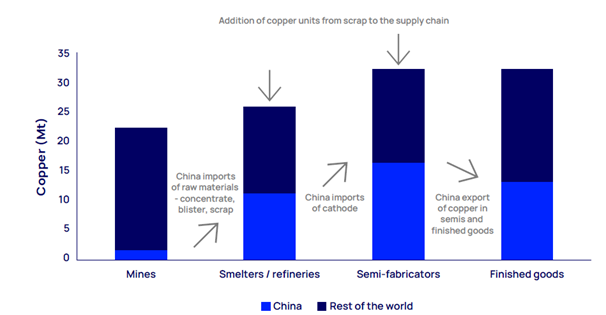
Source: Wood Mackenzie
The global copper supply chain is a complex system comprising four key stages: mining, smelting and refining, semi-fabricating, and manufacturing of finished goods. Copper flows from raw material extraction in the Americas and Africa to downstream processing and manufacturing, predominantly in China. The country’s substantial investments in downstream processing and semi-manufacturing sectors present significant challenges to global copper supply security.
The report states that since 2000, China has accounted for 75% of global smelter capacity growth and currently controls 97% of global smelting and refining capacity, contributing over 3 Mt of production and nearly US$25 billion in investment. The country has also added nearly 11 Mt of copper and alloy capacity since 2019, representing around 80% of global additions. Approximately two-thirds of these facilities produce wire rods, giving China half of the world’s fabrication capacity, with further expansion underway.
Growth in global copper smelter capacity is dominated by China
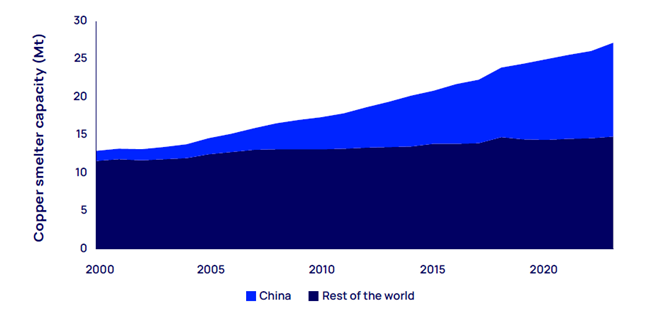
Source: Wood Mackenzie Lens Metals & Mining*
“China's copper smelting industry has undergone significant evolution,” said Zhifei Liu, managing consultant, copper markets at Wood Mackenzie. “In the 2000s, a drive for stricter environmental and efficiency standards led to the modernisation of smelting capabilities.
“Today, Chinese smelters are low cost and meet high environmental standards, particularly in sulphur dioxide capture, making them highly competitive.”
Pickens added that semi-fabricators outside of China, especially in Europe, are facing challenges due to lower utilisation and higher operating costs. Regulations on carbon emissions, like the European Union’s Carbon Border Adjustment Mechanism, could reduce competitiveness by imposing higher taxes on the European copper industry without providing equivalent benefits. Additionally, US government incentives such as the Inflation Reduction Act may not ensure the long-term sustainability of the industry.
The report also highlights significant shifts in the global copper smelting landscape, with new facilities set to come online this year outside China. India is launching a custom smelter, Indonesia is adding two integrated smelters, and a new smelter in the Democratic Republic of the Congo is expected to be completed by 2025, primarily driven by Chinese investment. According to Wood Mackenzie, these additions will add 1.6 Mt to global smelting capacity, the largest increase outside China in decades.
However, there are no plans for new primary smelting capacities in North America or Europe. Instead, the US is focusing on the secondary market and scrap copper, including establishing its first secondary smelter for complex materials in Georgia.
“While copper supply risks can be mitigated and some rebalancing has begun in various countries, the scale of China’s dominance in the supply chain means complete replacement is unfeasible,” said Pickens. “The introduction of new processing and fabrication facilities may result in higher costs and delays in the energy transition.
“Financing these investments presents additional hurdles, with resistance to new smelter projects on environmental and social grounds particularly strong in Europe. Pragmatism and compromise will be essential to achieve net zero goals without imposing excessive costs on taxpayers. Easing global trade restrictions could be one necessary concession.”
ENDS
Editor note:
The global shift toward clean energy and decarbonisation hinges significantly on copper. With the increasing demand for copper, efforts to secure critical minerals and reduce reliance on China's supply pose challenges. Although the necessity for investing in new mines is evident, the effects on downstream processing and semi-manufacturing are frequently disregarded. Our latest Horizons report addresses these issues. You can read it here.
Wood Mackenzie Lens Metals & Mining is an integrated cross-commodity data analytics platform for key mined commodities, providing a complete picture of how markets and assets develop within the energy and natural resource value chain across Wood Mackenzie’s energy transition scenarios.
- 娇龙耀新年 红运启新颜 法国娇兰携手上海豫园璀璨开启娇兰鸿运夜
- 抖音网红低价业务下单24小时,真人播阅读放量粉丝
- 正在进行时!西有毕加索 东有郭泰来 —— 郭泰来现代艺术大展开幕了
- 工业内窥镜在航天航空领域的应用
- 为雪域高原乡村振兴发挥保险作用——中国平安在西藏那曲比如县开展“牦牛险”的背后
- 东软医疗亮相第89届CMEF,全线高端,智能焕新!
- Nexo控告保加利亚,索赔逾30亿美元
- 安芯易COO做客深圳交通广播,解码“五大关键词” 构建学习型组织
- 海信5G+荣耀家系列主动硬核净护呼吸健康
- 南京干冰的图片干冰供应南京干冰生产
推荐
-
 产业数字化 为何需要一朵实体云?
改革开放前,国内供应链主要依靠指标拉动,其逻
资讯
产业数字化 为何需要一朵实体云?
改革开放前,国内供应链主要依靠指标拉动,其逻
资讯
-
 看新东方创始人俞敏洪如何回应董宇辉新号分流的?
(来源:中国证券报)
东方甄选净利润大幅下滑
资讯
看新东方创始人俞敏洪如何回应董宇辉新号分流的?
(来源:中国证券报)
东方甄选净利润大幅下滑
资讯
-
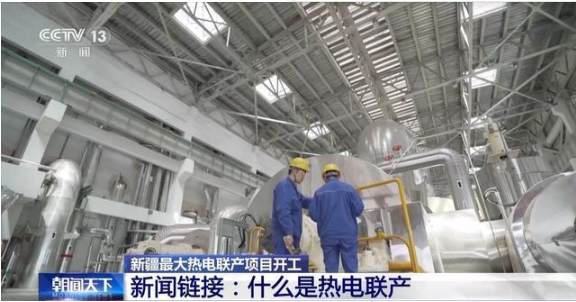 新增供热能力3200万平方米 新疆最大热电联产项目开工
昨天(26日),新疆最大的热电联产项目—&md
资讯
新增供热能力3200万平方米 新疆最大热电联产项目开工
昨天(26日),新疆最大的热电联产项目—&md
资讯
-
 奥运冠军刘翔更新社交账号晒出近照 时隔473天更新动态!
2月20日凌晨2点,奥运冠军刘翔更新社交账号晒
资讯
奥运冠军刘翔更新社交账号晒出近照 时隔473天更新动态!
2月20日凌晨2点,奥运冠军刘翔更新社交账号晒
资讯
-
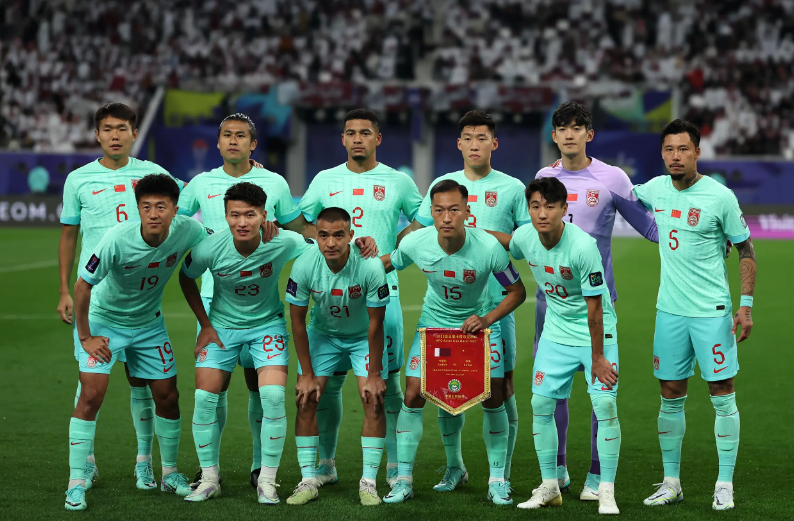 国足13次出战亚洲杯首次小组赛0进球
北京时间1月23日消息,2023亚洲杯小组
资讯
国足13次出战亚洲杯首次小组赛0进球
北京时间1月23日消息,2023亚洲杯小组
资讯
-
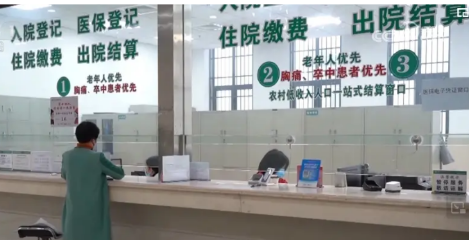 透过数据看城乡居民医保“含金量” 缴费标准是否合理?
记者从国家医保局了解到,近期,全国大部分地区
资讯
透过数据看城乡居民医保“含金量” 缴费标准是否合理?
记者从国家医保局了解到,近期,全国大部分地区
资讯
-
 海南大学生返校机票贵 有什么好的解决办法吗?
近日,有网友在“人民网领导留言板&rdqu
资讯
海南大学生返校机票贵 有什么好的解决办法吗?
近日,有网友在“人民网领导留言板&rdqu
资讯
-
 一个“江浙沪人家的孩子已经不卷学习了”的新闻引发议论纷纷
星标★
来源:桌子的生活观(ID:zzdshg)
没
资讯
一个“江浙沪人家的孩子已经不卷学习了”的新闻引发议论纷纷
星标★
来源:桌子的生活观(ID:zzdshg)
没
资讯
-
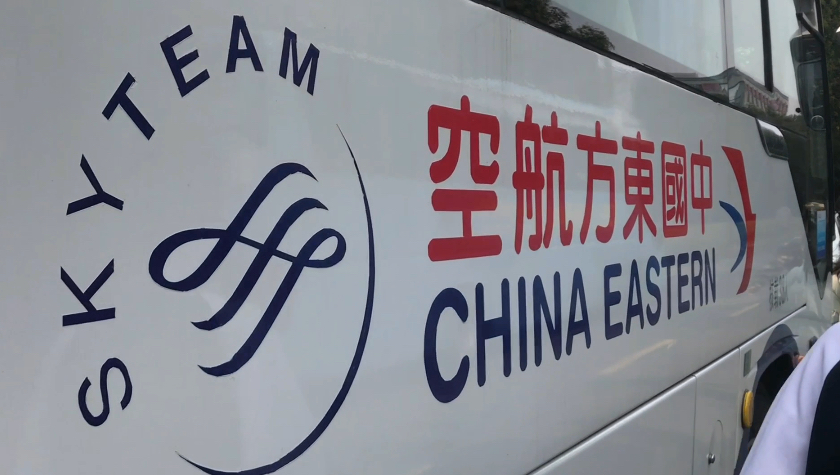 男子“机闹”后航班取消,同机旅客准备集体起诉
1月4日,一男子大闹飞机致航班取消的新闻登上
资讯
男子“机闹”后航班取消,同机旅客准备集体起诉
1月4日,一男子大闹飞机致航班取消的新闻登上
资讯
-
 周星驰新片《少林女足》在台湾省举办海选,吸引了不少素人和足球爱好者前来参加
周星驰新片《少林女足》在台湾省举办海选,吸
资讯
周星驰新片《少林女足》在台湾省举办海选,吸引了不少素人和足球爱好者前来参加
周星驰新片《少林女足》在台湾省举办海选,吸
资讯

